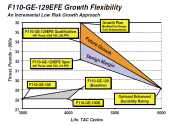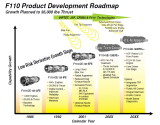Wrong example. RD-9 is made by scaling DOWN the AM-3 engine.Of course you can make it bigger. Compare the Mikulin AM-3 with the Tumansky RD-9 from the same era.
You are using an out of date browser. It may not display this or other websites correctly.
You should upgrade or use an alternative browser.
You should upgrade or use an alternative browser.
Chinese Engine Development
- Thread starter jackbh
- Start date
It's said that the very low bypass ratios of the ws-15 is not optimal for loitering. Supercruising speed and range are greatly increased but ferry ranges are slightly lower compared to ws10 variants.
For loitering, if you have the same engine core, is there any difference in fuel consumption between a high and low bypass airflow?
Low bypass just means less thrust. But when loitering, a J-20 isn't going anywhere.
And such thrust levels should still be adequate for a standard A2A loadout.
With larger bypass airflow more thrust is generated at low speeds so less fuel is needed for the same thrust. However bypass air is basically for cooling only at supersonic speeds and provide minimum benefit otherwise.For loitering, if you have the same engine core, is there any difference in fuel consumption between a high and low bypass airflow?
Low bypass just means less thrust. But when loitering, a J-20 isn't going anywhere.
And such thrust levels should still be adequate for a standard A2A loadout.
We should adjust our expectations of the WS-10. Comparing it to the F110 gives me the following conclusions:
WS-10A=F110-GE-100 with lower MTBO
WS-10B=F110-GE-129 with varying degrees of MTBO of between F110-GE-100 and F110-GE-132 on lower rating setting (3000-4300-6000 TAC)
WS-10C=F110-GE-132 with added stealth characteristics with equivalent MTBO (4300 TAC)
WS-10C2=proposed F110-GE-134 with lower MTBO (sub 4000 TAC)


WS-10A=F110-GE-100 with lower MTBO
WS-10B=F110-GE-129 with varying degrees of MTBO of between F110-GE-100 and F110-GE-132 on lower rating setting (3000-4300-6000 TAC)
WS-10C=F110-GE-132 with added stealth characteristics with equivalent MTBO (4300 TAC)
WS-10C2=proposed F110-GE-134 with lower MTBO (sub 4000 TAC)


Last edited:
(Cross posting my reply in the J-20 thread).We should adjust our expectations of the WS-10. Comparing it to the F110 gives me the following conclusions:
WS-10A=F110-GE-100 with lower MTBO
WS-10B=F110-GE-129 with varying degrees of MTBO of between F110-GE-100 and F110-GE-132 on lower rating setting (3000-4300-6000 TAC)
WS-10C=F110-GE-132 with added stealth characteristics with equivalent MTBO (4300 TAC)
WS-10C2=proposed F110-GE-134 with lower MTBO (sub 4000 TAC)


The below was the actual potential upgrade path. The F110 engine core should be capable of more growth than where its development stopped at.
“Even though the F110 is one of the highest thrust fighter engines in operation, GE has developed plans for further performance increases, should our customers need them. We have defined three growth steps that could increase F110 thrust to more than 40,000 pounds (178 kilo- Newtons ). The first step would deliver a 15 to 20 percent thrust increase to about 33,000 to 35,000 pounds (156 kilo- Newtons ). Engine ratings will depend on customer requirements. As an alternative, this step could provide a 40 percent increase in engine parts life at current thrust levels. Development work is already underway, and the engine will be qualified in 1998. Hardware modifications would include the high efficiency three stage integrally bladed disk - or blisk - fan adapted from the F118 engine on the B-2 bomber. We would also apply an advanced augmentor design using air-cooled radial flameholder and spraybar assemblies adopted from the YF120 and F414 engines. This low cost derivative design will greatly extend flameholder life. Survivability features could be incorporated to reduce engine thermal and radar signatures.”
looks like this is how Shenyang developing WS-10 engine family.(Cross posting my reply in the J-20 thread).
The below was the actual potential upgrade path. The F110 engine core should be capable of more growth than where its development stopped at.
“Even though the F110 is one of the highest thrust fighter engines in operation, GE has developed plans for further performance increases, should our customers need them. We have defined three growth steps that could increase F110 thrust to more than 40,000 pounds (178 kilo- Newtons ). The first step would deliver a 15 to 20 percent thrust increase to about 33,000 to 35,000 pounds (156 kilo- Newtons ). Engine ratings will depend on customer requirements. As an alternative, this step could provide a 40 percent increase in engine parts life at current thrust levels. Development work is already underway, and the engine will be qualified in 1998. Hardware modifications would include the high efficiency three stage integrally bladed disk - or blisk - fan adapted from the F118 engine on the B-2 bomber. We would also apply an advanced augmentor design using air-cooled radial flameholder and spraybar assemblies adopted from the YF120 and F414 engines. This low cost derivative design will greatly extend flameholder life. Survivability features could be incorporated to reduce engine thermal and radar signatures.”
they are working on ACE with existing Engine core.
there is another clean-sheet ACE/VCE project led by different AECC subsidiary.A VCE based on WS-10 might be a good fit for the J-36 indeed.
